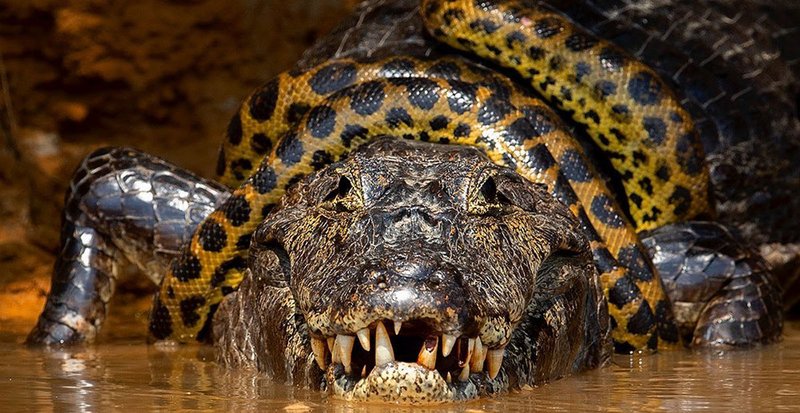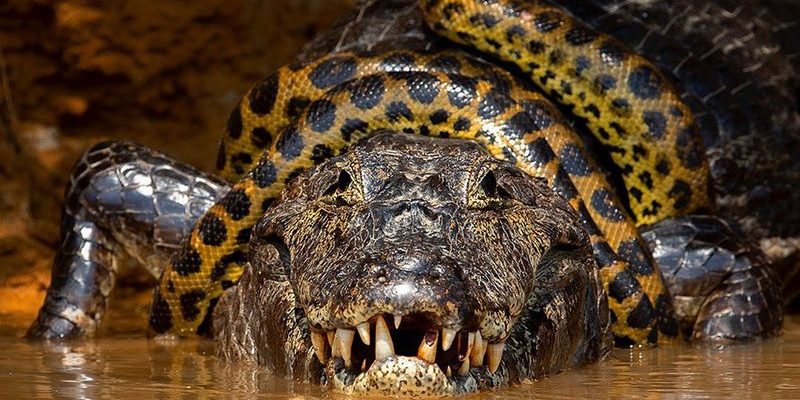
Hunting isn’t just about luck for the green anaconda; it’s an art form that showcases its unique adaptations. You might be surprised to learn that this snake uses a combination of stealth, strength, and strategy to catch its meals. So, what does the green anaconda usually like to munch on, and how does it go about snagging its next meal? Grab a cup of coffee, and let’s explore!
Diving Into The Green Anaconda’s Diet
The green anaconda’s diet is both diverse and impressive. These snakes are carnivorous, meaning they primarily consume meat. Found in the swamps and rivers of South America, their food sources vary based on their environment and availability. Typically, they eat:
- Fish
- Birds
- Mammals, such as capybaras and deer
- Reptiles, like caimans
You might be wondering how a snake as large as the anaconda can manage such hefty meals. Its jaw is uniquely structured. Rather than being rigid, the green anaconda can expand its jaw significantly to accommodate large prey. Picture it as a stretchy pair of pants that can adjust to fit different sizes.
Hunting Techniques of The Green Anaconda
Here’s where things get really interesting. The green anaconda isn’t just a brute force predator; it’s also incredibly clever. Most of its hunts happen in water, which provides an advantage and a bit of a challenge. One popular technique is known as ambush hunting.
In this strategy, the anaconda lies in wait, partially submerged and camouflaged among the plants. When an unsuspecting animal gets too close, it strikes with lightning speed. The snake’s muscle strength helps it wrap around its prey in a powerful, constricting embrace. The wrapping process is intense; it squeezes until the prey can’t breathe, making it easier to swallow whole.
Imagine trying to catch a slippery fish with your bare hands; it’s tricky! That’s why anacondas have perfected the art of stealth, often using the current of the water to hide their movements. They can even approach prey silently.
The Role of Size and Strength in Hunting
The size of the green anaconda is a crucial asset when hunting. They can grow over 30 feet long and weigh more than 500 pounds! This immense size gives them strength and a wide range of potential prey. But it’s not just brute strength; it’s about how they use that size effectively.
When tackling larger animals, like a deer, the anaconda’s bulk helps immobilize its prey quickly. The sheer weight can pin down the animal, preventing it from escaping. Think about a heavyweight wrestler taking down an opponent; that’s the kind of power the anaconda brings to its hunting game!
Fun fact: Anacondas can keep their bodies hidden while still being able to strike at prey. They use their environment to their advantage, ensuring they remain unnoticed until the perfect moment.
Prey Preferences: What Do They Eat Most Often?
While green anacondas are capable of consuming a variety of creatures, they have their favorites. Their most common prey typically includes:
- Capybaras: These large rodents are a staple in the anaconda’s diet, thanks to their abundance in the wetlands.
- Fish: Being skilled swimmers, green anacondas can easily catch fish as a primary food source.
- Birds: From ducks to larger fowl, birds are an easy target when they come near the water.
Interestingly, while large mammals like deer can be on the menu, they’re not as frequently caught as smaller prey. It requires a lot of energy and risk for an anaconda to tackle such big game. Often, they stick to prey that is easier to manage, ensuring they get enough food without expending too much effort.
Feeding Habits: How Often and When?
You might think that such a massive predator would have a huge appetite, but that’s not always the case. Green anacondas can go days or even weeks without eating after consuming a large meal. This is because their bodies are incredibly efficient at digesting food. When they do eat, they can consume prey up to half their body size!
So, when do they hunt? Anacondas are primarily nocturnal, which means they’re most active during the night. This gives them a better chance at surprising their prey in the dim light and cooler temperatures. Plus, being in the water at night allows them to blend in seamlessly with their surroundings.
The Importance of Hunting for Ecosystems
The role of the green anaconda in its ecosystem is vital. As both predator and prey, these snakes help maintain balance in their habitats. By controlling populations of species they consume, they prevent overpopulation, which can lead to resource depletion in their ecosystems.
Conversely, young anacondas are prey for larger predators like jaguars and birds of prey. This relationship keeps the food chain in check, showing that even the mighty green anaconda is part of a larger system. The balance of nature is delicate, and every species plays a part, no matter how big or small.
So, there you have it! The green anaconda is not just a formidable predator; it’s also a fascinating creature with unique hunting methods and a diverse menu. Whether it’s slipping through water to catch a fish or using ambush tactics to hunt larger mammals, this snake demonstrates the incredible adaptability of nature.
Next time you hear about the green anaconda, remember the way it hunts, what it eats, and the role it plays in its ecosystem. It’s one of those beautiful examples of how nature operates, showing us just how interconnected all living things are.

